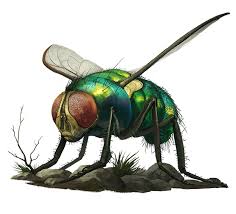The Mysterious Giant Fly: Understanding Horse Flies and Their Unique Characteristics
If you’ve ever encountered an unusually large fly buzzing around, you may have wondered what exactly it was. These “giant flies” are likely horse flies, a type of biting fly that is significantly larger than most other common fly species. Known for their size, strength, and sometimes painful bite, horse flies are a fascinating yet often unwelcome presence in many parts of the world.
What Are Horse Flies?
Horse flies belong to the family Tabanidae, a group that includes a variety of large, fast-flying, biting flies. The most common species of horse flies range in size from approximately ½ inch to 1 ¼ inches in length, making them noticeably larger than other familiar pests such as house flies, stable flies, or horn flies.
One of the most distinctive features of horse flies is their robust, sturdy body. Unlike the slender bodies of many smaller flies, horse flies have a thick, almost muscular appearance, with their body often covered in small hairs. This hairy exterior can sometimes give them a fuzzy look, which, combined with their large size, makes them easy to identify.
Physical Characteristics
Horse flies are easily recognized by their size, but they also have other distinguishing features:
- Eyes: Horse flies have large, often vividly colored compound eyes that can take up a significant portion of their head. These eyes are typically green or purple with bands or patterns, adding to their striking appearance. The eyes of horse flies are incredibly efficient, giving them excellent vision, which is crucial for locating prey and avoiding predators.
- Mouthparts: Perhaps the most notorious feature of horse flies is their mouthparts, which are designed for cutting and slicing through the skin of their hosts. Unlike mosquitoes, which have needle-like mouthparts for piercing skin and sucking blood, horse flies use their strong, scissor-like mouthparts to slice open the skin, creating a painful wound from which they feed.
- Wings: The wings of horse flies are large and powerful, allowing them to fly quickly and over long distances. Some species have clear wings, while others may have wings with dark patterns or bands.
Behavior and Habitat
Horse flies are found in various environments, including forests, fields, wetlands, and areas near bodies of water. They are especially prevalent in warm, humid climates and are most active during the day, particularly in the summer months.
These flies are known for their aggressive behavior when feeding. Female horse flies are the ones that bite, as they require a blood meal to develop their eggs. They feed on the blood of mammals, including humans, livestock, and wild animals. Male horse flies, on the other hand, do not bite; they primarily feed on nectar and plant juices.
One of the reasons horse flies are so persistent and annoying is their ability to detect movement and heat. They are attracted to the carbon dioxide exhaled by animals and humans, as well as the warmth of their bodies. Once they locate a host, they often attack in swarms, making them difficult to avoid.
The Impact of Horse Flies
The bite of a horse fly is not only painful but can also cause significant irritation and allergic reactions in some individuals. The wound left by a horse fly bite can become swollen and may take several days to heal. For livestock and other animals, the bites can lead to stress, decreased productivity, and in severe cases, infections or diseases transmitted by the flies.
In agricultural settings, horse flies can be a major nuisance. They are known to harass cattle, horses, and other livestock, sometimes causing animals to lose weight or suffer from reduced milk production due to the stress of constant biting. As a result, controlling horse fly populations is a priority for many farmers and ranchers.
Controlling and Preventing Horse Fly Bites
Due to their size and persistence, horse flies can be challenging to control. However, there are several strategies that can help reduce their impact:
- Protective Clothing: Wearing long sleeves, pants, and hats can provide some protection against horse fly bites when spending time outdoors in areas where these flies are common.
- Insect Repellents: Applying insect repellent to exposed skin can help deter horse flies. Products containing DEET, picaridin, or oil of lemon eucalyptus are often effective.
- Physical Barriers: For livestock, using fly sheets, masks, and other protective coverings can help keep horse flies at bay. Additionally, installing screens or using fans in barns and stables can help reduce fly activity.
- Traps: There are various traps designed to capture and kill horse flies. These traps often use light, color, or movement to attract the flies, which are then trapped or killed.
Conclusion
Horse flies, with their large size and aggressive behavior, are among the most noticeable and unwelcome pests in many outdoor environments. Their painful bites and persistent nature make them a significant nuisance to both humans and animals. Understanding their characteristics, behaviors, and how to protect against them can help minimize their impact, allowing for more enjoyable outdoor experiences and healthier livestock. While they may be fascinating creatures in their own right, when it comes to dealing with horse flies, prevention and protection are key.




